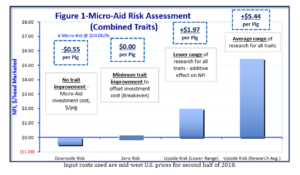Economics and Risk Analysis—Micro-Aid® is a Timely Opportunity!
Livestock production globally is under pressure for profitability. Feed input prices are relatively low. Abundant supplies of market-ready livestock are influencing market prices to be lower than desired by producers. How does that scenario impact the decision to use Micro-Aid®? The following analysis evaluates the investment in Micro-Aid® as compared with the risk of return for a farrow to finish swine operation. Please note that similar trends are currently recognized in other livestock and poultry enterprises as well.
The Analytical Process: This analysis evaluated four points, including 1) down side risk, 2) zero risk, 3) upside risk at low response, and 4) upside risk at average response. The Micro-Aid® Value Proposition Model “decision tool” was used to perform the analysis. Last half of 2018 cash input costs and lean hog futures prices were assumed. Conservative retail pricing was used for Micro-Aid®. Added profitability was not included for improving manure nutrient value.

Down Side Risk: The left-hand data in Figure 1 shows that if Micro-Aid® is included in all feed from farrow to finish at full retail pricing and no benefits are attributed to profitability, the only down side risk is a loss of $0.55 (USD) per pig marketed. Remember that environmental benefits and nutrient value of manure were not considered. Note that Micro-Aid® has a very low, down side risk, even in a marginally profitable market scenario.
Zero Risk: The process identified how much improvement in performance is required to cover the investment in Micro-Aid®. The second set of data in Figure 1 demonstrates this “break even” or zero risk proposition. With previously mentioned assumptions, an improvement of 0.40% in average daily gain and 0.22% in feed efficiency combined with a 0.06 pig per litter reduction in stillbirths and a 0.05 pig per litter reduction in pre-weaning mortality covers the investment cost of Micro-Aid® for the entire feeding period. Compare this minimal level of improvement needed to achieve zero risk to the typical level of improvement shown in the extensive research discussed below. The security of nearly “zero risk” is offered for including Micro-Aid® farrow to finish with current economics!
Upside Risk at Low Response Range: This point evaluated the upside risk possible if performance was attained in the low range of performance from proprietary research. Assumptions in the low range included a 5.5-pound improvement in gain throughout the feeding period and a 0.027 reduction in feed efficiency combined with a 0.33 pig per litter improvement in stillbirths and a .05 pig per litter improvement in pre-weaning mortality. The third column of data in Figure 1 shows that with these low-end assumptions an estimated return of $1.97 (USD) per pig marketed would be realized. Again, low investment for a high return, even at the low end of the research documented performance improvement!
Upside Risk at Average Response: When using the assumptions for performance improvement consistent with the average response in extensive controlled research over time, Micro-Aid® provided a significant improvement in return. In this analysis, the average 4.3% improvement in average daily gain and 3.35% improvement in feed efficiency was combined with a 36.5% reduction in stillbirths and a 17.3% reduction in pre-weaning mortality. Those average assumptions, demonstrated in Figure 1, yielded an estimated return of $5.44 (USD) per pig marketed after covering the investment in Micro-Aid®. Upside risk potential is significant!
Decision Point: If you have ever considered using Micro-Aid® technology, now is the time. With today’s economics, the downside risk is small and requires minimal performance improvement to offset that risk. On the other hand, the upside risk provides an excellent return even at the lower end of research demonstrated performance improvement. This represents the ideal financial investment with low risk and high return. Timing has never been better for Micro-Aid® in all feed, all the time!

